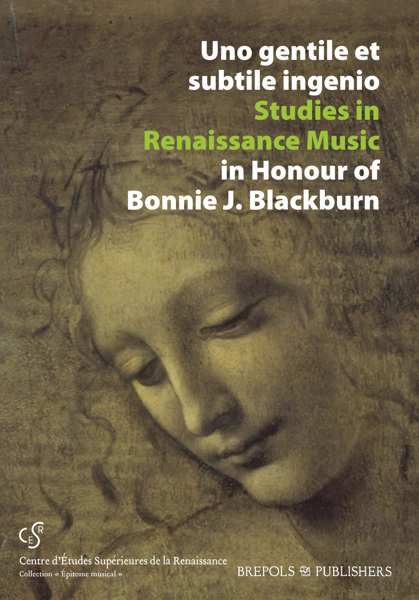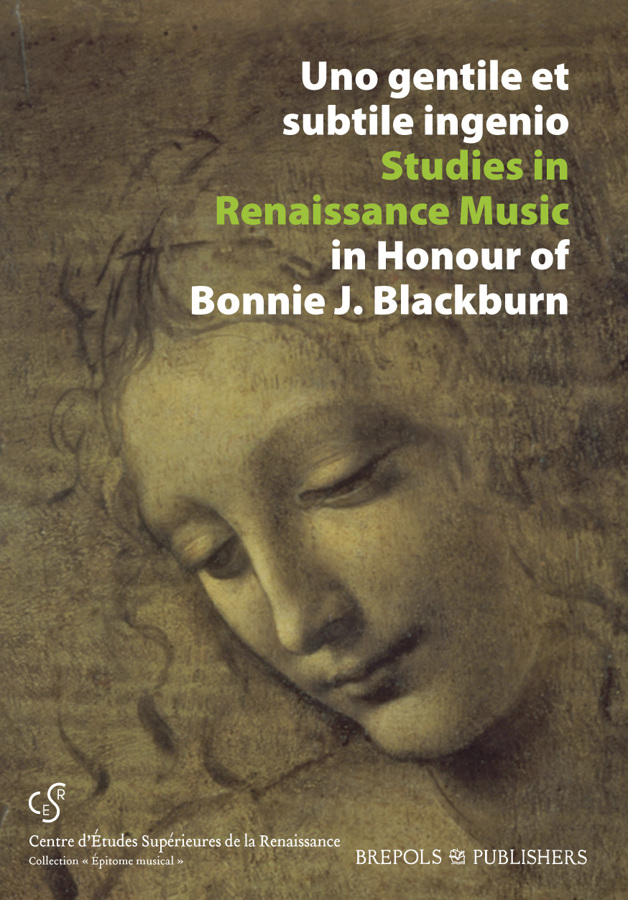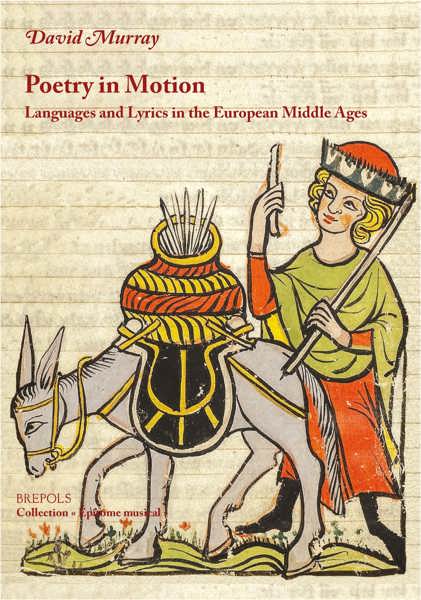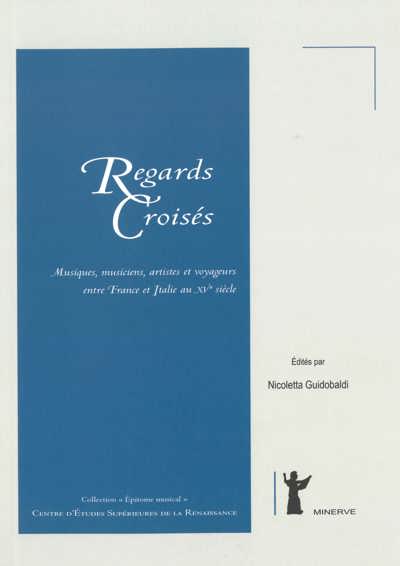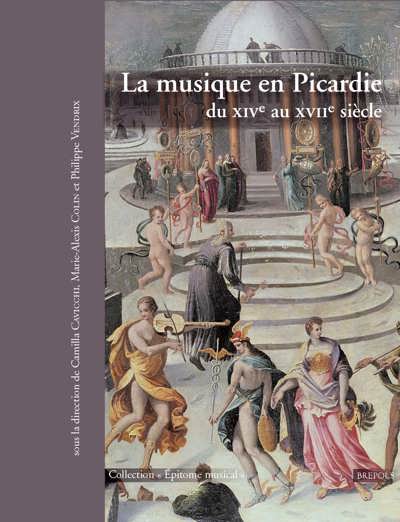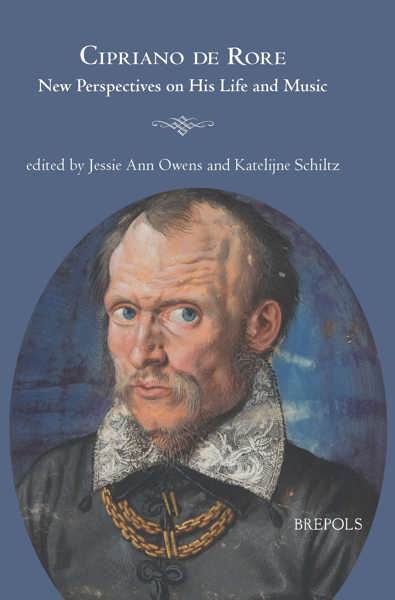
Uno gentile et subtile ingenio
Studies in Renaissance Music in Honour of Bonnie J. Blackburn
Gioia Filocamo, M. Jennifer Bloxam (eds)
- Pages: 877 p.
- Size:190 x 290 mm
- Language(s):English, French, Italian
- Publication Year:2009
- € 115,00 EXCL. VAT RETAIL PRICE
- ISBN: 978-2-503-53163-2
- Hardback
- Available
- € 115,00 EXCL. VAT RETAIL PRICE
- ISBN: 978-2-503-53764-1
- E-book
- Available
"(...) this is an extraordinary important book. (...) The Blackburn Festschrift belongs on the shelves of any academic library that seriously supports musicological research." (D. F. Scott, in: Notes, Quarterly Journal of the Music Association, Vol. 68/2, December 2011, p. 324-332)
I. Composition and Counterpoint
Margaret Bent, Naming of Parts: Notes on the Contratenor, c.1350–1450 - Anna Maria Busse Berger, The Problem of Diminished Counterpoint - Tim Carter, ‘Improvised’ Counterpoint in Monteverdi’s 1610 Vespers - Fabrice Fitch, Towards a Taxonomy of the ‘Eton Style’ - Jessie Ann Owens, ‘El foglio rigato’ Revisited: Prepared Paper in Musical Composition - Stephen Rice, Aspects of Counterpoint Theory in the Tractado de canto mensurable (1535) of Matheo de Aranda
II. Devotion
In Northern Europe
Barbara Haggh, The Beguines of Bruges and the Procession of the Holy Blood - Alejandro Enrique Planchart, The Polyphonic Proses of Guillaume Du Fay
In Italy
Frank A. D’Accone, Francesco Corteccia’s Hymn for St. John’s Day in the Florentine Liturgy, ca.1544-1737 - Thomas Schmidt-Beste, The Repertoire of the Papal Chapel after the Council of Trent: Tradition, Innovation, or Decline? - Laurie Stras, Imitation, Meditation and Penance: Don Lodovico Agostini’s Le lagrime del peccatore (1586) - Giovanni Zanovello, « In oratorio nemo aliquid agat »: Savonarola, lo spazio sacro e la musica
In Spain
Tess Knighton, Marian Devotions in Early Sixteenth-Century Spain: The Case of the Bishop of Palencia, Juan Rodríguez de Fonseca (1451–1524) - Kenneth Kreitner, The Ceremonial Soft Band of Fifteenth-Century Barcelona - Michael Noone, An Early Seventeenth-Century Source for Performing Practices at Toledo Cathedral
III. Lives
Paula Higgins, Speaking of the Devil and Discipuli: Eloy d’Amerval, Saint-Martin of Tours, And Music in the Loire Valley, ca. 1465–1505 - Herbert Kellman, Dad and Granddad Were Cops: Josquin’s Ancestry - Lewis Lockwood, ‘It’s true that Josquin composes better . . .’: The Short Unhappy Life of Gian de Artiganova
IV. Manuscripts
Northern Europe
David Fallows, The Contents of the Herdringen Scores - Gioia Filocamo, Sulle orme di Ulrich Schubinger ‘il giovane’: repertorio ‘vivo’ dal codice musicale Augsburg, Staats- und Stadtbibliothek, 2o 142a - Birgit Lodes, Des Kaisers Alamire: Zur Entstehung des Chorbuchs Wien, Österreichische Nationalbibliothek, Mus. Hs. 15495
Central Europe
Agnieszka Leszczynska, Franciscus de Rivulo and the Manuscript Gdansk, Biblioteka Gdanska Polskiej Akademii Nauk 4003 - Peter Wright, Polyphony for Corpus Christi in an Unknown Fragmentary Source from Mid-Fifteenth-Century Central Europe: An Interim Report
Italy
Warren Drake, A Postscript to Petrucci’s Motetti B: A Closer Look at the ‘Secret Manuscript’ in the Paris Copy - Arnaldo Morelli, « Galli cantant »: Maestri di cappella francesi in uno sconosciuto manoscritto di metà Cinquecento - Joshua Rifkin, A Scriptor, a Singer, and a Mother Superior: Another Story about MS DCCLXI of the Biblioteca Capitolare in Verona - Richard Sherr, Thoughts on Some of the Masses in Vatican City, Biblioteca Apostolica Vaticana, MS Cappella Sistina 14 and its Concordant Sources (or, Things Bonnie Won’t Let Me Publish) - Alice tacaille, Notes sur la copie des messes de Josquin des Prés dans un manuscrit italien de la fin du XVIe siècle
V. Music
Masses and their Models
Cathy Ann Elias, A New Look at Cantus Firmus Process in Crecquillon’s Missa Kain Adler in der Welt so schön - Rebecca L. Gerber, A Fifteenth-Century Pellegrina and Standley’s ‘Harmony of the Spheres’ Mass - Bernadette Nelson, Patterns of Emulation and Influence in the Fors seulement Polyphonic Mass Tradition: New Insight Revealed through Music in Toledo - Véronique Roelvink, Benedictus dominus deus Israel: A Motet by Johannes Lupi and a Mass by Gheerkin de Hondt - Owen Rees, Parody and Patriotism: A Sebastianist Reading of the Masses of Filipe de Magalhães
Motets: Analysis, Context, and Attribution
Willem Elders, Perfect Fifths and the Holy Virgin’s Immaculate Conception: On Ficta in Josquin’s five-part Inviolata - Sean Gallagher Busnoys, Burgundy, and the Song of Songs - Edward F. Houghton, The Anonymous Motets of the Chigi Codex - Christian Thomas Leitmeir, How Many Keys Are There to a Lock? Contextualizing a 16th-Century Motet - Patrick Macey, Josquin and Champion: Conflicting Attributions for the Psalm Motet De profundis clamavi - Martin Staehelin, Eine Trauermotette von Costanzo Festa auf Heinrich Isaac? - Jennifer Thomas, Absalon fili mi, Josquin, and the French Royal Court: Attribution, Authenticity, Context, and Conjecture
Poetry and Song
Richard Freedman, ‘Ainsi meurs vif’: The Paradox of Choice in Renaissance Song - James Haar, ‘La dolce vista del tuo viso pio’: Du Fay and the Italian Song Tradition - Elizabeth Eva Leach, The Unquiet Thoughts of Edmund Spenser’s Scudamour and John Dowland’s First Booke of Songes - John Milsom, Josquin and the Act of Self-Quotation: The Case of Plusieurs regretz - Massimo Privitera, ‘Un baciar furioso, un dispogliarsi’: Costanzo Festa and Eroticism - Blake Wilson, ‘Transferring Tunes and Adjusting Lines’: Leonardo Giustinian and the Giustiniana in Quattrocento Florence
Puzzles and Canons
Jaap van Benthem, ‘La prima donna del mondo’: Isabella d’Este’s Musical Impresa, its Conception, and an Interpretation - Lawrence F. Bernstein, Ockeghem as ‘The Bach of his Day’ - Eric Jas, Multivoiced Canons attributed to Josquin - Klaus Pietschmann, Zirkelkanon im Niemandsland: Ikonographie und Symbolik im Chansonnier Florenz, Biblioteca Nazionale Centrale, Banco Rari 229 - William F. Prizer, The ‘Virtue’ of Lorenzo Lotto: A Musical Intarsia in the Basilica of Santa Maria Maggiore in Bergamo - Katelijne Schiltz, Through the Looking-Glass: Pietro Cerone’s Enigma del espejo
VI. Production and Consumption
In Northern Europe
Mary S. Lewis, The Italian Madrigal in Germany: A New Assessment of its Early Reception - Honey Meconi, A Cultural Theory of the Chansonnier - Keith Polk, English Instrumental Music in the Fifteenth Century
In Italy
Jane A. Bernstein, Made to Order: Choirbook Publications in Cinquecento Rome - Donna G. Cardamone, Musical Comedy at the Prince of Salerno’s Palace in Naples - Anthony M. Cummings, Music and Theatre in Leo X’s Rome - Gianluca D’Agostino, « Napolitani … eccellentissimi musici, della composizione e del suono »: Aspetti della vita musicale a Napoli nel Cinquecento - Melanie Marshall, Grateful Friends, True Friends: Gifts of Music and Poetry Associated with Girolamo Fenaruolo - Reinhard Strohm, Enea Silvio Piccolomini and Music
VII. Teachers and Theorists
Anne-Emmanuelle Ceulemans, Le Lucidario in musica de Pietro Aaron - Jeffrey J. Dean, Josquin’s Teaching: Ignored and Lost Sources - Leofranc Holford-Strevens, The Erudition of Florentius de Faxolis and Blasius Romerus - Saskia C. M. M. Rolsma, Theory in Practice: Reminiscences of Gaffurius’ Music Theory in the Milanese Choirbooks - Rob C. Wegman, Tinctoris’s Magnum opus
